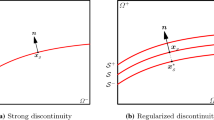Abstract
The effects of tension and compression along a crack on the plastic zone in a finite anisotropic body under plane strain are studied. The formation pattern for the plastic zone with increasing load is established by numerically solving a boundary-value problem for each of the cases. In particular, a new plastic zone is revealed. It occurs at the crack face under a compressive load of certain magnitude. How this plastic zone interacts with that at the crack tip is established
Similar content being viewed by others
References
A. A. Il’yushin, “Some issues of the theory of plastic strains,” Prikl. Mat. Mekh., 7, No. 4, 245–272 (1943).
E. E. Kurchakov, “Stress-strain relation for nonlinear anisotropic medium,” Int. Appl. Mech., 15, No. 9, 803–807 (1979).
E. E. Kurchakov, Analysis of Tensor-Linear Constitutive Equations for a Nonlinear Anisotropic Body [in Russian], Manuscript No. 5544-A86_dep. at VINITI 07.30.86, Kyiv (1986).
A. N. Guz, M. Sh. Dyshel’, and V. M. Nazarenko, Fracture and Stability of Cracked Materials, Vol. 4 of the four-volume five-book series Nonclassical Problems of Fracture Mechanics [in Russian], Naukova Dumka, Kyiv (1992).
V. Z. Parton and E. M. Morozov, Mechanics of Elastoplastic Fracture [in Russian], Nauka, Moscow (1985).
J. Rice, “Mathematical methods in fracture mechanics,” in: H. Liebowitz (ed.), Fracture, Vol. 2: Mathematical Fundamentals, Academic Press, New York (1971).
V. N. Bastun and A. A. Kaminsky, “Applied problems in the mechanics of strain hardening of structural metallic materials,” Int. Appl. Mech., 41, No. 10, 1192–1029 (2005).
A. N. Guz, “On some nonclassical problems of fracture mechanics taking into account the stresses along cracks,” Int. Appl. Mech., 40, No. 8, 937–941 (2004).
H. Hencky, “Zur Theorie der plastische Deformationen,” in: Proc. 1st Int. Congr. on Applied Mechanics, Delft (1924), pp. 312–317.
A. A. Kaminsky and G. V. Galatenko, “Two-parameter model of a mode I crack in an elastoplastic body under plane-strain conditions,” Int. Appl. Mech., 41, No. 6, 621–630 (2005).
A. A. Kaminsky, M. V. Dudyk, and L. A. Kipnis, “On the direction of development of a thin fracture process zone at the tip of an interfacial crack between dissimilar media,” Int. Appl. Mech., 42, No. 2, 136–144 (2006).
A. A. Kaminsky, E. E. Kurchakov, and G. V. Gavrilov, “Study of the plastic zone near a crack in an anisotropic body,” Int. Appl. Mech., 42, No. 7, 749–764 (2006).
R. Mises, “Mechanik der festen Korper im plastisch deformablen Zustand,” Nachrichten von der Koniglichen Gesellschaft der Wissenschaften zu Gottingen, Matematisch-Physikalische Klasse, No. 4, 582–592 (1913).
A. Nadai, Plasticity, McGraw-Hill, New York-London (1931).
W. Olszak and W. Urbanowski, “The plastic potential and the generalized distortion energy in the theory of non-homogeneous anisotropic elastic-plastic bodies,” Arch. Mech. Stos., 8, No. 4, 671–694 (1956).
Author information
Authors and Affiliations
Additional information
__________
Translated from Prikladnaya Mekhanika, Vol. 43, No. 5, pp. 3–19, May 2007.
Rights and permissions
About this article
Cite this article
Kaminsky, A.A., Kurchakov, E.E. & Gavrilov, G.V. Formation of a plastic zone in an anisotropic body under loads acting along a crack. Int Appl Mech 43, 475–490 (2007). https://doi.org/10.1007/s10778-007-0045-3
Received:
Issue Date:
DOI: https://doi.org/10.1007/s10778-007-0045-3




